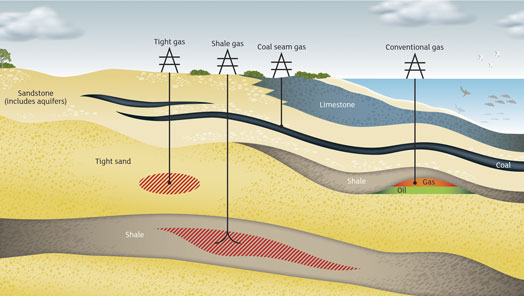Types of onshore gas
Onshore gas is found deep under the land surface in sedimentary rocks. The majority of gas supplied to Victorian consumers to date has been produced from offshore hydrocarbon fields under the seabed.
Onshore gas can be found in different sedimentary rocks known as:
- tight sandstones (tight gas)
- shales (shale gas)
- coal seams (coal seam gas)
- porous sandstones (conventional gas).
The main difference between tight gas, shale gas, coal seam gas and conventional gas is the type of rock that the gas is found in and the way in which the gas is stored. The methods used to produce gas from these different sources may also vary.
Tight gas
Tight gas is sourced from relatively low permeability and low porosity sedimentary reservoirs. The lack of permeability does not allow the gas to migrate out of the rock. In this case the method to extract gas may involve fracturing the rocks to create artificial porosity and permeability. The Victorian Government banned hydraulic fracturing (fracking) in 2017, following community concerns.
Shale gas
Shale gas is sourced from very fine-grained sedimentary rocks that have low porosity and permeability and are organic-rich. The gas is held in organic matter in the rock, in tiny pores between grains and any fractures present in the rock. As for tight gas, fracturing the rocks to create artificial porosity and permeability will release the gas. The Victorian Government banned hydraulic fracturing (fracking) in 2017, following community concerns.
Coal seam gas
Coal seam gas, also called coal bed methane, refers to naturally occurring methane in coal seams. The gas is held on coal surfaces and trapped by water pressure in the gaps and cracks in the coal seams. In order to allow the gas to flow, water is drawn away from the seams to release the gas into a gas well. The Victorian Government banned the production of coal seam gas in 2017, following community concerns.
Conventional gas
Conventional gas is stored in porous and permeable sedimentary rocks such as sandstones or limestones in a geological structure known as a trap. Impermeable rocks directly above the structure trap the gas. A well drilled into the structure intersects the porous reservoir and gas flows into the well. (N.B. The moratorium on the exploration and production of onshore conventional gas in Victoria will be lifted from 1 July 2021.)
Types of natural gas

Where is onshore gas found?
Onshore natural gas is found around Australia including in New South Wales, Queensland, South Australia and the Northern Territory.
In Victoria, gas may be found in three broad areas. These are known as sedimentary basins and are named after the areas they cover: the Gippsland Basin, the Otway Basin and the Murray Basin. The basin boundaries are defined on the basis of their geology – they contain layers of sedimentary rocks (e.g. sandstones and shales) that have been deposited, buried, compacted; and in most cases folded and faulted by movement within the Earth's crust over many millions of years.
Victoria's Gippsland and Otway sedimentary basins have an onshore and an offshore component. Exploration for oil and gas has happened for around 100 years in the onshore Gippsland and Otway basins. However, the majority of oil and gas discoveries and production to date have been from the offshore Gippsland and Otway basins. Relatively small amounts of gas have been produced from conventional traps in the onshore Otway Basin. One of these traps is now used to store gas at Port Campbell; the Iona Gas Plant.
There is currently no onshore natural gas production in Victoria. Exploration is at an early stage. It is unknown whether the State has any defined resources of conventional gas in onshore areas that could be drawn on a commercial, basis. The areas prospective for onshore gas in Victoria are shown in the map below.
The Geological Survey of Victoria considers the Gippsland geological basin to be less prospective than the Otway geological basin for onshore conventional gas.
Page last updated: 01 Dec 2021